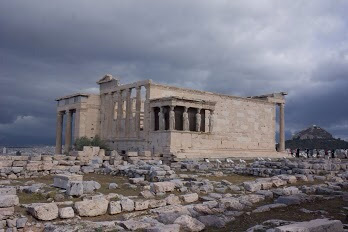We heard from our guide, Ellie, that the word 'acropolis' means the highest point of the city and there were many acropolises, i.e. fortified crags or citadels, throughout Mycenaean Greece. It was one such citadel, the acropolis of Athens, that we know today as the Acropolis.
Over time the role of the Acropolis changed and it became more exclusively the city's main religious centre and home to some of the masterpieces of the Ancient Greeks. It was the Archaic and Classical eras that left their mark on the sacred rock.
We learned that there had been great building activity in the 6th century including the first large temple on the spot where 100 years later the Parthenon would be built. The 5th century saw the wars between the Greeks and the Persians and, as we stood on the Acropolis looking down over Athens, we were told the stories of the Athenians winning the battle of Marathon, followed by the Persians' second invasion when they set fire to Athens and the Acropolis. We looked out towards the island of Salamis where the Athenians fled to and from where they lured the Persians down by setting fire to some of their boats and, by secreting their own boats round the back of the island, ambushed the Persians and crushed them at the great battle of Salamis. As we looked out from the Acropolis over modern Athens one could easily imagine the clear view the Persians would have had over the empty plain there would then have been between the citadel and the sea.
The victorious wars over the Persians marked the beginning of the most glorious era in the history of Athens. We learned that it was under the leadership of Pericles that the city reached its zenith. He signed peace treaties with the enemies and in that era of peace and prosperity planned a great building programme including the monumental entrance to the sacred area of the Acropolis, and the Parthenon, the marble temple to Athena. This flourishing period came to an end with the Poloponnesian War with Sparta, although some building continued with fine works of art in the 4th century BC.
 Athens was fought over for many centuries by the Romans, the Byzantines and the Ottomans. The Turks filled the Acropolis with houses and, for some unexplained reason, stored gunpowder in the Parthenon. It is believed that when the Venetians sieged the city in 1687 a shell fell onto the Parthenon, setting off the gunpowder, and blew away a large section. Precious sculptures fell to the ground, broke into pieces and were collected by Lord Elgin and others in the following century.
Athens was fought over for many centuries by the Romans, the Byzantines and the Ottomans. The Turks filled the Acropolis with houses and, for some unexplained reason, stored gunpowder in the Parthenon. It is believed that when the Venetians sieged the city in 1687 a shell fell onto the Parthenon, setting off the gunpowder, and blew away a large section. Precious sculptures fell to the ground, broke into pieces and were collected by Lord Elgin and others in the following century. 


No comments:
Post a Comment